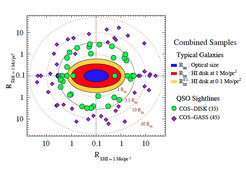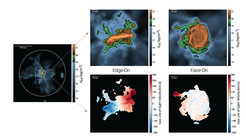The Circum-galactic Medium of Galaxies as Probe of Gas Accretion

Galaxies need gas to fuel star formation; how galaxies acquire gas is therefore central to our understanding of galaxy evolution. In the standard paradigm, galaxies grow primarily through the accretion of gas that flows from the Inter-Galactic Medium (IGM), through the dark matter halo, and eventually settling onto the disk of the galaxy. Galaxies like or own Milky Way need a continuous supply of gas to fuel star formation, but little is known about the way in which gas cools and condenses into the disk due to difficulties in observationally mapping the disk/halo interface.
Bright quasars at large distances from the observer act as cosmic light beacons. As the light from distant quasars travels through the Universe, it encounters gas clouds containing mainly hydrogen. These clouds absorb and scatter ultraviolet photons, leading to characteristic dips (or absorption lines) in the spectrum of the quasar, the so-called "Lyman α forest". By choosing quasars that happen to be positioned in such a way that their light will pass within a short distance (a few hundred kiloparsec) of a foreground galaxy, we are able to probe the gas in the so-called "circum-galactic medium" surrounding these systems.
Two large programmes to investigate the circum-galactic medium around nearby galaxies have now received a total allocation of 200 orbits of observation time with the Hubble Space Telescope (HST). The first of these, COS-GASS, used the Cosmic Origins Spectrograph (COS) on board HST to probe neutral hydrogen around nearby galaxies out to the outer radius of their surrounding dark matter halos.

Distribution of sight lines as a function of impact parameter and orientation of the target galaxy. The red and blue areas correspond to the HI and the optical disk. The yellow region corresponds to the extended disk region. The quasar sightlines included as part of the COS-GASS programme are shown in purple and the sightlines from the COS-DISK programme in green.
The COS-GASS programme found a highly significant correlation (at 99.5% confidence) between the strength of the Lyman α absorption lines, which are tracing neutral hydrogen in the surrounding halo, with the ratio of gas mass to stellar mass within the disk. This means that galaxies with gas-rich disks are embedded within gas-rich halos.
The Lyman α signature was detected in nearly every quasar spectrum and the average strength of the Lyman α lines decreased gradually as a function of distance from the galaxy. Finally, the strength of the Lyman α lines seems to be independent of the orientation of the disk. This means that the gas in the surrounding gas halos is distributed smoothly and relatively isotropically.
The quasar spectra obtained as part of the COS-GASS programme mainly probed sightlines well outside the disk of the galaxy. In 2015, the follow-on, large programme COS-DISK was approved to probe gas at the interface between disk and circum-galactic medium. While reduction, processing and analysis of the HST data is being carried out at Johns Hopkins University in Baltimore, MPA scientists are closely involved in using state-of-the-art cosmological hydro-dynamical simulations to interpret the observational data.
Most of the work so far has focused on the Illustris simulations. The simulation includes thousands of galaxies with masses in the range of the galaxies in the COS-GASS and COS-DISK samples, making it ideal for studying how the disk, circum-galactic medium and disk/halo interface properties vary as a function of the stellar mass of the galaxy, morphological type, star formation rate, and gas mass fraction.

An example from the Illustris simulations: the predicted distribution and kinematics of neutral hydrogen surrounding a simulated galaxy (with the same mass as the Milky Way). The image on the left shows the HI column density at the scale of the virial radius (white circle), the middle and right columns show edge on and face on projections of the HI column density (top) and the line of sight velocity (bottom).
A first comparison with the observational data shows that the observed correlation between the gas content of the halo and the gas content of the disk is well reproduced, as is the isotropic geometry of the neutral gas at large radii. However, the simulations do not match very well the observational result that almost all sightlines intercept a neutral gas cloud. The simulations incorporate various kinds of gas heating processes and these are clearly too effective at heating and destroying large pockets of neutral hydrogen far out into the halo.
Future work, motivated by new data from COS-DISK, will examine gas closer to the disk in more detail. The simulations predict that the gas in the inner circum-galactic medium should be co-rotating with the galaxy and our new observations will allow us to test this hypothesis. In addition, several large Illustris follow-up simulations will significantly improve upon the physical models used in the original Illustris simulations. Ongoing comparisons between new data and improved models will significantly improve our understanding of how galaxies grow by gas accretion.
Guinevere Kauffmann and Dylan Nelson














